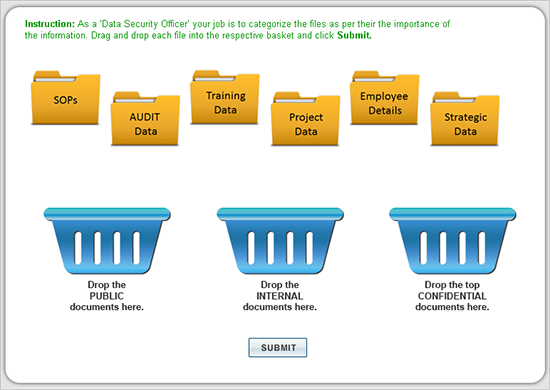3 Ways to Impart Code of Conduct Compliance Training Using E-learning

Code of conduct compliance training is slowly shifting its paradigm from “read and agree” documents to interactivities. Why? No matter how well-written your code of conduct is, mere learning of the rules will not give your employees and stakeholders clarity about the organization’s mission, values and principles. The employees and top management need to apply them in their workplace. Factoring in the popular terms associated with compliance training such as “dry” and “boring”, the task of imparting effective training becomes even harder.
→ Download eBook- eLearning Trends
So, how can you make your employees comply to apply? You can incorporate e-learning in your code of conduct compliance courses to make it more effective in various ways, out of which a few are stated below.
Scenarios
Scenarios are a powerful way of compelling your employees to apply their knowledge in real life situations. The engaging simulations, strong storyline and assessments help them imagine themselves in the characters’ shoes. This improves their decision-making capabilities whenever a similar situation materializes in their workplace.
For instance, the policies about improper gifts, travel and entertainment can be depicted as a scenario in an online compliance training. The scenario can contain an employee meeting a delegate and the learners taking the course can choose the right behavior in the form of a quiz. This will not only entertain your employees but also make them retain and apply what they learned in their workplace.

Videos
Videos are a simple yet powerful way of imparting knowledge to your employees. Providing code of conduct training in the form of videos doesn’t just engage your employees, but also helps them learn and retain the information faster and transfer it to their workplace.
Also, it is well known that code of conduct is not limited just to your employees, your third party business associates need to follow the code too. Conducting classroom training for them is highly impractical. Instead, the training videos can be shared with them and they can access these at their own pace.

For instance, a short video demonstrating the dos and don’ts of insider trading policy would stick better in your employees’ minds compared to just reading those rules. Videos can help your employees’ picture themselves in the situations, helping them apply the same in real life situations. Micro videos which don’t consume more than five minutes of your employees’ time can be used to impart code of conduct training effectively.

eLearning Trends for 2024
Seal the Deal with Success
- Training Formats for Upskilling and Reskilling
- Popular AI Tools for L&D
- Mastering the New-Age Learning Formats
- And More!
Game-based courses
Game-based courses adopt the strategy of incorporating game-like elements in the training courses. These can be ideal for training your employees on code of conduct as game-based courses are engaging and interactive. Providing leaderboards, badges, virtual prizes for completing or progressing in a course can motivate your employees the right way.

For instance, you can make your employees take a game-based course on corporate opportunities and assets which contains a quiz or a puzzle and each correct answer fetches a badge. The more badges one collects, the higher he goes in the leaderboard. The badges can also be given contextual names such as Mr. Honest or Mr. Prudent. This will not only entertain your employees but also help them remember the various rules of code of conduct compliance.
What happens when the code is violated
Proper damage control can avert your organization from facing the worst outcome, if at all a breach occurs. But for this to work, your employees need to retain information about incidence response. This training about what actions to take when a breach occurs and whom to report to can be provided using eLearning in an engaging way, helping them retain as well as apply it.
Adopting various e-learning techniques can help impart dry and boring compliance rules in an engaging way, make your employees apply them in their workplace, reinforce learning and improve their decision-making skills.





